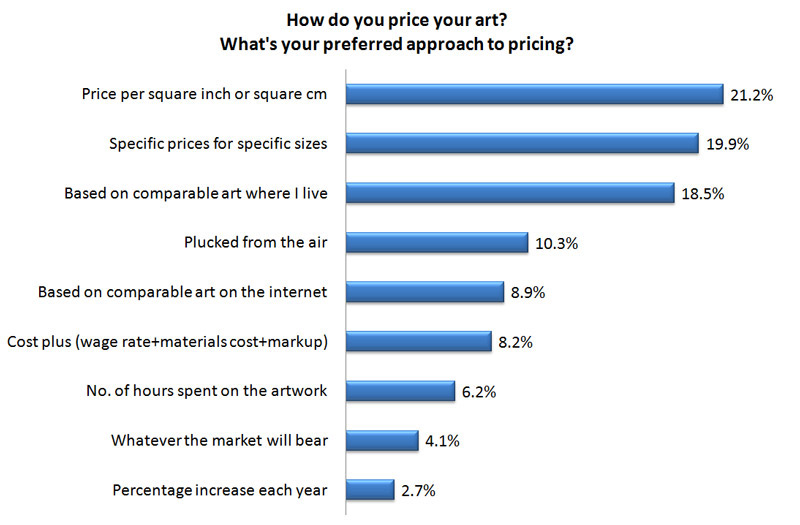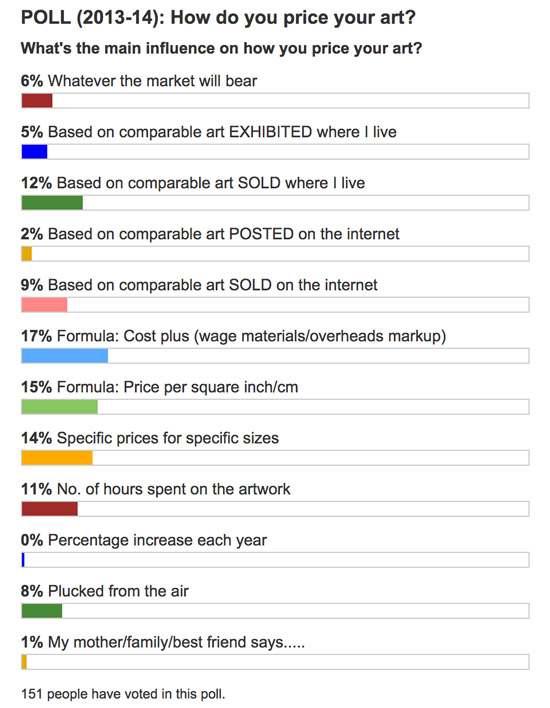- Home
- NEWS
-
PRACTICE
-
MARKETING
- How to write an Artist's Statement >
- How to write an Artist's Resume or CV >
- How to sign a painting, drawing or fine art print
- Business Cards for Artists
- How to write a press release for an artist
- The Private View Invitation
- Publicity for Juried Exhibitions
- Websites for Artists >
- Image & Video sizes for Social Media Sites
- How to be mobile-friendly
-
SELL ART
- FRAME ART
-
SHIP ART
-
COPYRIGHT
-
MONEY & TAX
- About + Help
- BANKING
How you price your art is changing. How does what you do fit with what other people are doing?
This page looks at how artists price their art - in terms of responses to polls I've been running on this topic since 2009.
Below you can:
Below you can:
- complete the current polls
- review the results of previous polls
- consider the trends and changes in the popular methods for pricing art between 2009 and 2016
How do you price your art in 2018?
Please complete these polls.
If you click 'view results' to the right of the 'Vote' button you can see how your action compares to others
If you click 'view results' to the right of the 'Vote' button you can see how your action compares to others
|
POLL: WHAT INFLUENCES HOW YOU PRICE YOUR ART?
Before you read on think about what approach you use to price your art and complete the poll |
POLL: WHERE DO YOU EXHIBIT YOUR PRICES?
Based on a poll on a previous website |
Previous Polls
|
In 2009, I conducted a poll about how artists priced their art on my blog (see chart).
What type of art they produced was of less important to what type of approach they used for pricing their drawings and paintings. 146 people took part in the poll - and this is what they said:
What this says to me is that artists tried very hard to be consistent in their pricing - in relation to size and place where it is sold. |
POLL (2009) How do you price your art
You can read more about the poll in Results of "How do you price your art?" |
|
In 2013/14 I ran the poll again and got slightly different results ( see chart).
This time 151 people took part in the poll. All three top options from 2009 had reduced in percentage terms
The top option for pricing art in 2013/14 was a cost plus formula based on an understanding of how much art cost to make and how much mark-up was required to cover overheads and make a profit It seems as if artists were getting better at understanding their input costs and overheads. |
The Most Popular Approaches to Pricing Art
|
BASED ON COMPARABLE ART (exhibited | sold) WHERE I LIVE - INCREASING POPULARITY
The artist studies prices displayed in local galleries and other places where art is sold and finds a comparable artist in terms of media and/or subject matter and relates prices to these. This is an increasingly a popular option. Artists now seem to recognise that they MUST know what artwork sells for in their local area. In 2014
Pros
|
COST PLUS (WAGE RATE+MATERIALS COST+MARKUP) - INCREASED
The artist determines an hourly rate for their work, adds in the cost of materials (and matting and framing if applicable) and then adds a flat rate or a percentage as a mark-up which covers marketing and other business expenses and/or a profit element. This option became much more popular in 2014 perhaps because the recession has made artists look much more carefully at what their input costs were and what sort of markup they should be seeking It's maintaining popularity over time - maybe as more artists have become more business-oriented? Pros
|
|
SPECIFIC PRICES FOR SPECIFIC SIZES - DECREASING
A common approach when artists typically produce artwork in a specific set of sizes. A set price per size makes exhibition pricing more sensible Still popular but gradually decreasing in popularity over time. Pros
It's sensible if artists work out which sizes sell best BEFORE determining the prices they want to set for different sizes. This then helps an artist to decide how to allocate their time before different sized artwork. The more pieces you produce in the size and price range that has a good track record for sales, the more likely you are to achieve actual sales in reality. |
PRICE PER SQUARE INCH/CM - DECREASING
A standard price per square inch or centimetre is determined by the artist and this is then applied to all artwork. This option is on the decline. Possibly because it doesn't achieve good business results. The standard price must have some foundation in fact to be work properly. A number of artists commented that size was immaterial - and that in fact it was more difficult and took longer to produce quality artwork in small sizes! Pros
|
|
The Artist's Guide to Selling Work
by Annabelle Ruston Rated an average of 4.2 out of 5 stars based on 12 customer reviews Breaks the basics of selling artwork down into readable 'chunks'. Includes a chapter about setting prices for original artwork. BUY IN UK Artist's Guide to Selling Work
|
Least Popular Options for Pricing Art
The options with the fewest votes might be deemed least popular. But are they?
|
PERCENTAGE INCREASE EACH YEAR - UNPOPULAR
This approach is often used by an emerging artist who wants to grow sales income over time. The emphasis is always on relating to prices charged in previous years rather than what the market will bear or is currently paying for comparable work or input costs. Pros
In 2014, nobody was using this method. Given the recession post 2008 this is hardly surprising given that inflation in a number of countries was running at a low level. |
BASED ON COMPARABLE ART ON THE INTERNET - DECREASING / UNPOPULAR?
The artist looks at what else is available on the Internet and picks an artist or group of artists, notes the prices asked (or achieved at auction) and then adjusts accordingly. Pros
More astute artists search for information about the price asked which actually achieves a sale. In 2014
|
Alternative approaches
The two options in the middle of the pack are based on gut feel - and some research.
|
NO. OF HOURS SPENT ON THE ARTWORK - unclear trend
The price is determined by a calculated hourly rate based on the notion that materials costs are incidental and the crucial cost driver is the number of hours required to complete the work. Pros
Artists did confess to feeling guilty for charging high prices - and getting sales - for artwork which didn't take long to do. To which my response is to ask how long have you spent working at your art so that you can work quickly and with skill? |
PLUCKED FROM THE AIR - unclear trend
This is the "it feels like a $500 painting to me" approach. It's often used by those who want to avoid doing any research to check out the current state of the marketplace. However I've used this one from time to time and my guess is most people probably have at one time or another. Pros
I recommend that if you want to use this approach that you:
What I do is go and see exhibitions and collect exhibition catalogues! I make notes about what work sells and what the price thresholds for sales of different sizes of work seem to be. The best time to do this is just before an exhibition finishes as it provides a snapshot of how the market is working. |
Other options identified
Artists participating in the survey also identified other ways of pricing art.
These included:
These included:
- Gallery guides on/decides pricing policy for an artist's work
- If the artist likes a piece a lot then it has to have a high enough price which would make a sale worthwhile!
ABOUT ART BUSINESS INFO. FOR ARTISTS
This website aims to provide a compendium of resources about the art business for artists. Please read "PLEASE NOTE"
It helps artists learn how to do better at being business-like, marketing and selling their art and looking after their financial security.
This website aims to provide a compendium of resources about the art business for artists. Please read "PLEASE NOTE"
It helps artists learn how to do better at being business-like, marketing and selling their art and looking after their financial security.
|
Copyright: 2015-2021 Katherine Tyrrell | Making A Mark Publications
- all rights reserved If you've got any suggestions for what you'd like to see on this website please send me your suggestion
|
PLEASE NOTE:
1) Content and the law change all the time. It's impossible to keep up with it if you're not working on the topic full time. 2) I research topics carefully. However, I am totally unable to warrant that ANY and/or ALL information is
|
3) Hence all information I provide comes without any LIABILITY whatsoever to you for any choices you make.
4) This website is FREE FOR YOU but not for me. Links to books are Amazon Affiliate links. Buying a book via this website means I get a very small payment which helps to fund and maintain this website. .I much appreciate any support your provide. Adverts are provided by Google AdSense - but the adverts do not mean I endorse the advertiser. |
- Home
- NEWS
-
PRACTICE
-
MARKETING
- How to write an Artist's Statement >
- How to write an Artist's Resume or CV >
- How to sign a painting, drawing or fine art print
- Business Cards for Artists
- How to write a press release for an artist
- The Private View Invitation
- Publicity for Juried Exhibitions
- Websites for Artists >
- Image & Video sizes for Social Media Sites
- How to be mobile-friendly
-
SELL ART
- FRAME ART
-
SHIP ART
-
COPYRIGHT
-
MONEY & TAX
- About + Help
- BANKING


